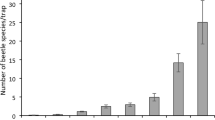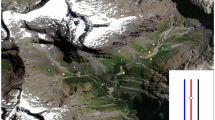Abstract
There is a pressing need to develop simplified sampling protocols that allow invertebrates to be routinely incorporated into terrestrial faunal surveys for informing conservation planning. This study assesses the usefulness of sampling invertebrate by-catch from standard vertebrate bucket pitfall traps for documenting spatial patterns of terrestrial invertebrates. We compare among-site (N = 78) patterns of species richness and composition of ten invertebrate families (comprising ants, beetles and spiders) captured in vertebrate bucket traps with those captured in two different arrays of invertebrate-specific pitfall traps. For three families (Formicidae, Carabidae and Lycosidae) patterns of richness and composition captured in the vertebrate traps were comparable with those captured in the invertebrate-specific trap arrays. Thus, in some cases, vertebrate traps appeared to be as useful in detecting patterns of invertebrate diversity as were invertebrate-specific traps. Our findings show that sampling invertebrate by-catch from vertebrate bucket traps can be a reliable and robust simplified protocol for documenting biodiversity patterns for some key groups of terrestrial invertebrates. This simplified protocol can take terrestrial invertebrates out of the ‘too-hard basket’ for biodiversity assessment and monitoring, breaking the positive-feedback loop that currently maintains ignorance of invertebrate diversity and distribution and that prevents their inclusion in conservation planning.



Similar content being viewed by others
References
Abensperg-Traun M, Steven D (1995) The effects of pitfall trap diameter on ant species richness (Hymenoptera: Formicidae) and species composition of the catch in a semi-arid eucalypt woodland. Aust J Ecol 20:282–287
Andersen AN (1991) Responses of ground-foraging ant communities to three experimental fire regimes in a savanna forest of tropical Australia. Biotropica 23:575–585
Andersen AN (1993) Ants as indicators of restoration success at a uranium mine in tropical Australia. Restor Ecol 1:156–167
Andersen AN, Lowe LM, Rentz D (2000) The grasshopper (Orthoptera: Acridoidea, Eumastacoidea and Tettigonioidea) fauna of Kakadu National Park in the Australian seasonal tropics: biogeography, habitat associations and functional groups. Aust J Zool 48:431–442
Andersen AN, Hoffmann BD, Müller WJ, Griffiths AD (2002) Using ants as bioindicators in land management: simplifying assessment of ant community responses. J Appl Ecol 39:8–17
Andersen AN, Fisher A, Hoffmann BD, Read JL, Richards R (2004) Use of terrestrial invertebrates for biodiversity monitoring in Australian rangelands, with particular reference to ants. Aust J Ecol 29:87–92
Arcoverde GB, Andersen AN, Leal IR, Setterlfield SA (2018) Habitat-contingent responses to disturbance: impact of cattle grazing on ant communities vary with habitat complexity. Ecol Appl 28:1808–1817
Braithwaite RW, Miller L, Wood JT (1988) The structure of termite communities in the Australian tropics. Aust J Ecol 13:375–391
Brennan KE, Majer JD, Reygaert N (1999) Determination of an optimal pitfall trap size for sampling spiders in a Western Australian Jarrah forest. J Insect Conserv 3:297–307
Brown GR, Matthews IM (2016) A review of extensive variation in the design of pitfall traps and a proposal for a standard pitfall trap design for monitoring ground-active arthropod biodiversity. Ecol Evol 6:3953–3964
Cheli GH, Corley JC (2010) Efficient sampling of ground-dwelling arthropods using pitfall traps in arid steppes. Neotrop Entomol 39:912–917
Clarke KR, Gorley RN (2015) Primer v7: user manual/tutorial. PRIMER-E Ltd, Plymout
Clarke KR, Somerfield PJ, Chapman MG (2006) On resemblance measures for ecological studies, including taxonomic dissimilarities and a zero-adjusted Bray–Curtis coefficient for denuded assemblages. J Exp Mar Biol Ecol 330:55–80
Durrant B (2009) Terrestrial invertebrate biodiversity assessment for the gnangara sustainability strategy (final report). Department of Environment and Conservation, Woodvale
Finlayson CM, von Oertzen I (eds)(2012) Landscape and vegetation ecology of the Kakadu Region, northern Australia, 1st edn. Kluwer Academic Publishers, Wolters Kluwer
Kikkawa J, Monteith G (1980) Animal ecology of monsoon forests of the Kakadu region, Northern Territory. Queensland Museum consultancy report to Director. Australian National Prks and Wildlife Service, Canberra
Knapp M, Ruzicka J (2012) The effect of pitfall trap construction and preservative on catch size, species richness and species composition of ground beetles (Coleoptera: Carabidae). Eur J Entomol 109:419
Lang A (2000) The pitfalls of pitfalls: a comparison of pitfall trap catches and absolute density estimates of epigeal invertebrate predators in arable land. Anzeiger für Schädlingskunde J Pest Sci 73:99–106
Luff M (1975) Some features influencing the efficiency of pitfall traps. Oecologia 19:345–357
New TR (1998) The role of ground beetles (Coleoptera: Carabidae) in monitoring programmes in Australia. Ann Zool Fenn 35:163–171
Pearce J, Schuurman D, Barber K, Larrivée M, Venier L, McKee J, McKenney D (2005) Pitfall trap designs to maximize invertebrate captures and minimize captures of nontarget vertebrates. Can Entomol 137:233–250
Pearsall IA (2007) Carabid beetles as ecological indicators. Paper presented at the “Monitoring the Effectiveness of Biological Conservation” conference, 2–4 November 2004, Richmond, B.C. http://www.forrex.org/events/mebc/papers.html. Accessed 13 Dec 2017
Pekár S (2002) Differential effects of formaldehyde concentration and detergent on the catching efficiency of surface active arthropods by pitfall traps. Pedobiologia 46:539–547
Phillips ID, Cobb TP (2005) Effects of habitat structure and lid transparency on pitfall catches. Environ Entomol 34:875–882
Press T, Brock J, Andersen A (1995) Fauna. In Press T, Lea D, Webb A, Alistair G (eds) Kakadu: Natural and Cultural Heritage and Management Australian Nature Conservation Agency, Darwin, pp 167–216
Sherley G, Stringer I (2016) DOCCM-248862 invertebrates: pitfall trapping v1.0. Department of Conservation Te Papa Atawhai, Wellington
Skvarla M, Larson J, Dowling A (2014) Pitfalls and preservatives: a review. J Entomol Soc Ont 145:15–43
Stork NE (1993) How many species are there? Biodivers Conserv 2:215–232
Taylor GS, Braby MF, Moir ML, Harvey MS, Sands DP, New TR, Kitching RL, McQuillan PB, Hogendoorn K, Glatz RV (2018) Strategic national approach for improving the conservation management of insects and allied invertebrates in Australia. Austral Entomology 57:124–149
Westby-Gibson J, Greenberg CH, Moorman CE, Forrest T, Keyser TL, Simon DM, Warburton GS (2017) Short-term response of ground-dwelling macroarthropods to shelterwood harvests in a productive Southern Appalachian upland hardwood forest. e-Res. Pap. RP-SRS-59. U.S. Department of Agriculture Forest Service, Southern Research Station, Asheville, p 10
Wilson EO (1987) The little things that run the world (the importance and conservation of invertebrates). Conserv Biol 1:344–346
Winderlich S, Woinarski J (eds) (2014) Kakadu National Park Landscape Symposia Series. Symposium 7: Conservation of threatened species, 26–27 March 2013, Bowali Visitor Centre, Kakadu National Park. Internal Report 623, June, Supervising Scientist, Darwin
Woinarski JC, Andersen AN, Churchill TB, Ash AJ (2002) Response of ant and terrestrial spider assemblages to pastoral and military land use, and to landscape position, in a tropical savanna woodland in northern Australia. Austral Ecol 27:324–333
Woinarski J, Mackey B, Nix H, Traill B (2007) The nature of northern Australia: natural values, ecological processes and future prospects. ANU, Canberra
Woinarski J, Armstrong M, Brennan K, Fisher A, Griffiths A, Hill B, Milne D, Palmer C, Ward S, Watson M (2010) Monitoring indicates rapid and severe decline of native small mammals in Kakadu National Park, northern Australia. Wildl Res 37:116–126
Work TT, Buddle CM, Korinus LM, Spence JR (2002) Pitfall trap size and capture of three taxa of litter-dwelling arthropods: implications for biodiversity studies. Environ Entomol 31:438–448
Acknowledgements
We sincerely thank the specialist taxonomists who validated species identifications of the target taxa: Tom Weir (ANIC), Rolf Oberprieler (ANIC), Adam Slipinski (ANIC), Martin Baehr (ZSM), Kip Will (University of California), Margaret Thayer (Field Museum of Natural History), Volker Framenau (Phoenix Consulting), Barbara Baehr (QM) and Barry Richardson (ANIC). We also thank Greg McCarthy (Department of Environment, Land, Water and Planning) for assistance with mapping software, and Graham Brown and Gavin Daly (Museum and Art Gallery of the Northern Territory, MAGNT) for information on and access to specimens in the MAGNT collection. For assistance in the field and laboratory we thank Jodie Hayward, Magen Petit, Debbie Jennings, Alice Delude, Clemence Maillot, Maud Beucher, Logan Penvern and Axelle Valero. We also thank Ben Hoffmann (CSIRO) and Alyson Stobo-Wilson (CDU) for their comments on this manuscript.
Author information
Authors and Affiliations
Corresponding author
Ethics declarations
Conflict of interest
The authors declare that they have no conflict of interest.
Additional information
Publisher’s Note
Springer Nature remains neutral with regard to jurisdictional claims in published maps and institutional affiliations.
Electronic supplementary material
Below is the link to the electronic supplementary material.
Rights and permissions
About this article
Cite this article
Oberprieler, S.K., Andersen, A.N. & Braby, M.F. Invertebrate by-catch from vertebrate pitfall traps can be useful for documenting patterns of invertebrate diversity. J Insect Conserv 23, 547–554 (2019). https://doi.org/10.1007/s10841-019-00143-z
Received:
Accepted:
Published:
Issue Date:
DOI: https://doi.org/10.1007/s10841-019-00143-z




